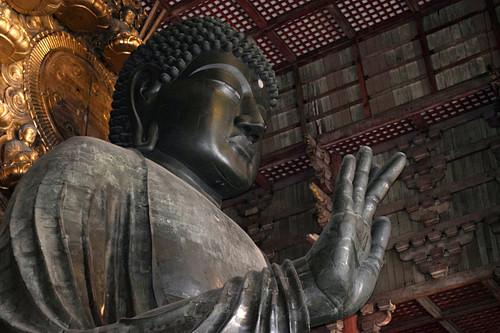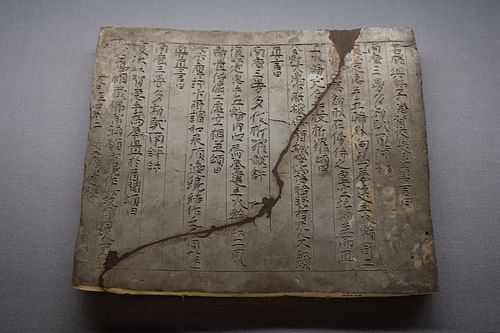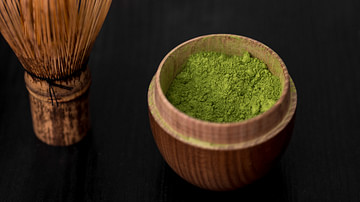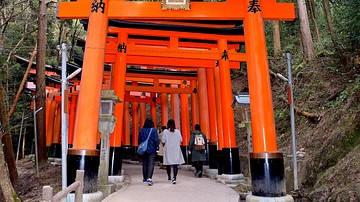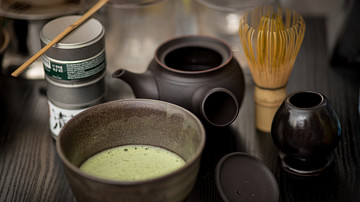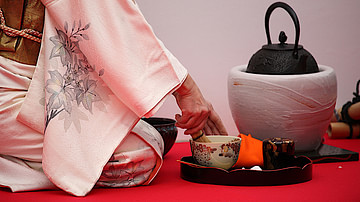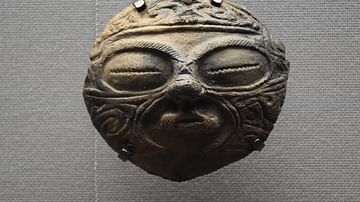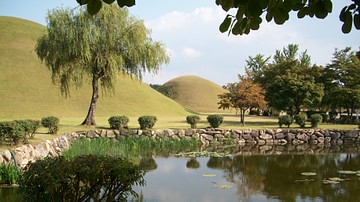Relations between ancient Japan and China have a long history, and in certain periods the exchange of political, religious and cultural practices between the two was intense. China, the much older state and the more developed, passed on to Japan (sometimes indirectly via Korea) a long list of ideas including rice cultivation, writing, Buddhism, centralised government models, civil service examinations, temple architecture, clothing, art, literature, music, and eating habits. Trade relations greatly outlasted cultural and diplomatic ties, with Japan beginning to develop its own unique cultural path from the 9th century CE onwards.
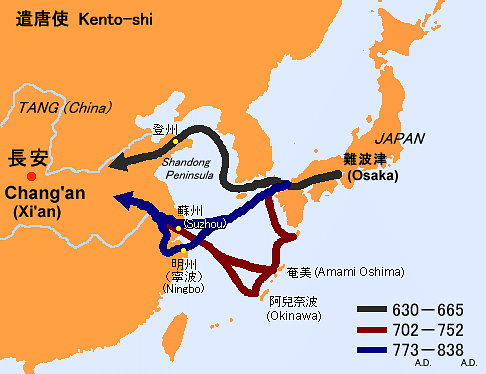
Early Contact
At the end of the Jomon Period, from around 400 BCE (or even earlier), Japan's first foreign contact was in the form of migrants who began to arrive from continental Asia, especially the Korean peninsula, probably driven by the wars caused by Chinese expansion and between rival kingdoms. They brought with them new pottery, bronze, iron, and improved metalworking techniques which produced more efficient farming tools and better weaponry and armour.
At a political level, Japan was beginning its first attempts at international relations (kokusai kankei) by the end of the Yayoi Period (c. 300 BCE or earlier to c. 250 CE). According to the c. 82 CE Han Shu ('History Of Han'), envoys and tribute were sent to the Chinese commanderies in northern Korea by the Wa, as the fledgeling confederation of small states in southern and western Japan was then known, the most important of which was Yamato. This is the earliest textual reference to Japan. A second early Chinese source is the 297 CE Wei Chih ('History of Wei'). The first tribute missions to China are recorded in 57 and 107 CE. One Japanese ruler known to have sent embassies to Chinese territory (238, 243, and c. 248 CE) and the most famous figure of the period was Queen Himiko (r. c. 189-248 CE). During the subsequent Kofun Period (c. 250 CE - 538 CE) envoys continued to be sent to China: in 425 CE, 478 CE and then eleven more up to 502 CE. Yamato Japan was slowly establishing an international diplomatic presence.
Asuka Period & Buddhism
The Asuka Period (538-710 CE) saw a stepping up of cultural exchange with the introduction of laws and penal codes based on those in China, the creation of a permanent capital city, and the nationalisation of land. There was also the introduction of Buddhism to Japan sometime in the 6th century CE, traditionally in 552 CE. It was actually introduced by a Korean monk but was seen as a Chinese faith and was officially adopted by Emperor Yomei (r. 585-587 CE). Buddhism reinforced the idea of a layered society with different levels of social status, with the emperor very much at the top and protected by the Four Guardian Kings of Buddhist law. The aristocracy could also conveniently claim that they enjoyed their privileged position in society because they had accumulated merit in a previous life.
The adoption of Buddhism, it was hoped, would be looked on favourably by the more advanced neighbouring cultures of Korea and China and enhance Japan's reputation as a rising civilised nation in East Asia. It was for the same reason that Chinese conventions of court etiquette, formal address and titles, and the ceremonies of drinking tea and eating habits were also copied. Once officially adopted, monks, scholars, and students were regularly sent to China to learn the tenets of Buddhism in more depth and bring back that knowledge, along with art and even sometimes relics, for the benefit of the Japanese people.
Buddhism continued to evolve as a faith in both India and China with new sects developing which eventually made their way to Japan via monks who studied abroad. Two of the most noted scholar monks were Kukai (774-835 CE) and Saicho (767-822 CE), who founded the Shingon and Tendai sects respectively. Another important monk was Ennin (c. 793-864 CE) who studied esoteric Buddhism in China for nine years and brought back to Japan these new ideas, original texts, mandalas, and ritual objects.
Diplomatic Missions
Prince Shotoku, who ruled as regent on behalf of Empress Suiko from 594 until his death in 622 CE, was a great promoter of ties with China and was a keen advocate of all things Chinese from chopsticks to Buddhism. His famous Seventeen Article Constitution of 604 CE was heavily influenced by Taoist, Confucian, and Buddhist ideas. Shotoku also sent official embassies to the Sui court in China from c. 607 CE and then throughout the 7th century CE. There would be 19 state-sponsored missions sent to China between 607 and 839 CE. The missions were led by a high-ranked court official who was accompanied by councillors, scholars, monks, artists, doctors, musicians, diviners, scribes, and interpreters. Thus each embassy could include several hundred people. The important officials had their expenses met by their hosts. 'Tribute' was given and gifts were received in return, especially paintings and books.
Artists copied what works they could to take home as reference works, musicians paid for lessons from famous teachers, and scholars (typically monks) studied under celebrated religious masters. Doctors acquired the arts of acupuncture, moxibustion, massage, and exorcism. Students would spend longer and not return with the main embassy. Studying for several years, their costs were, in most cases, also met by the Chinese government. Those who did take the time to study seriously in China were often rewarded with high positions on their return to Japan, becoming government advisors or heads of institutions such as Nara's university where Confucian principles were taught and the courses in Chinese literature and law were the most popular. Monks would continue to establish and head their own sects of Buddhism which became immensely popular as their new knowledge allowed them to usurp the position of existing schools and abbots.
Throughout the Asuka Period (538-710 CE) Japanese literature and music followed Chinese models as artists brought back ideas from mainland Asia. Similarly, architectural styles came from China. The architecture of the public buildings of Nara and its successor as capital Heiankyo (Kyoto) followed Chinese models with most buildings for public administration having crimson columns supporting green tiled roofs. Heiankyo was laid out on a regular grid plan with right angled streets creating regular-sized blocks along the Chinese model of the Western Capital at Ch'ang-an, just as Nara had been. The royal palace followed Chinese ideas, and the city even had an Academy of Chinese Learning (Daigaku-ryo). In contrast, private homes, storage houses, and farm buildings continued to be built according to the Japanese architectural tradition.
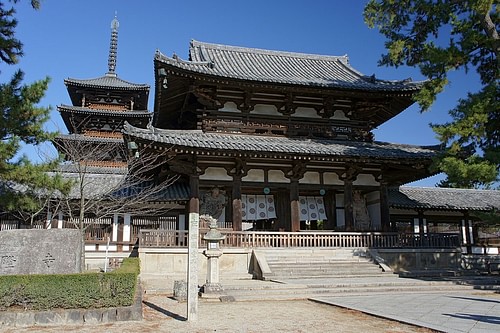
China did send embassies occasionally to Japan and missions are recorded to Kyushu, Nara, and Heiankyo. These, though, were not about the Chinese learning from Japan but rather an official seal of approval of Japan's acceptance as a 'tribute' nation. The Chinese brought valuable gifts and, even more importantly, the merchants who were able to establish lucrative and long-lasting trade relations with their Japanese counterparts. Indeed, the commerce between the two nations would far outlast the diplomatic relations.
Failed Relations
Relations with Japan's mainland neighbours were not always amicable. The Silla kingdom, a longtime rival of Baekje in the Korean peninsula finally overran its neighbour in 660 CE with the help of a massive Chinese Tang naval force. A rebel Baekje force persuaded Japan to send 800 ships under the command of Abe no Hirafu to aid their attempt to regain control of their kingdom, but the joint force was defeated at the Battle of Baekgang (Hakusonko) at the mouth of the Geum/Paekchon River in 663 CE. The success of the Unified Silla Kingdom resulted in another wave of immigrants entering Japan from the collapsed Baekje and Goguryeo kingdoms. Following their defeat, Japan could have been invaded by either Silla, the Tang, or both. A large fortification was built at Dazaifu in the south-east of Japan, but the threat of occupation never materialised.
Heian Period & Cooling of Relations
During the Heian Period (794-1185 CE), following a final embassy to the Tang court in 838 CE, there were no longer formal diplomatic relations with China as Japan became somewhat isolationist without any necessity to defend its borders or embark on territorial conquest. Around 900 CE, the great Tang Dynasty collapsed and China became a disunity of competing states. This fact, the danger of sailing to the continent, and an increasing reaction against Chinese influence with a corresponding desire for the Japanese to exert their own political development meant that diplomatic missions petered out between the two states.
Flourishing Trade
Although political missions declined, sporadic trade and cultural exchanges continued with China, as before. Goods imported from China were largely luxury items, but the list is diverse and included medicines, perfumes, worked silk fabrics, damask, brocades, ceramics, weapons, armour, cloves, musk, lapis lazuli, cinnabar, dyes, and musical instruments. Books came too, a catalogue dating to 891 CE lists more than 1,700 Chinese titles made available in Japan which cover history, poetry, court protocols, medicine, laws, and Confucian classics. Japan sent in return pearls, gold dust, silver, amber, agate, raw silk, camelia oil, mercury, sulphur, paper, and gilt lacquerware. Still, despite these exchanges, the lack of regular missions between the two states from the 10th century CE meant that the Heian Period overall saw a diminishing in the influence of Chinese culture, which meant that Japanese culture began to find its own unique path of development.
In the 13th century CE, at the very end of the ancient period, the Mongols overran China and then set their sights on Japan. When Japan refused to become a subject nation of the mighty Kublai Khan's empire, a massive invasion force was assembled. Twice, in 1274 and 1281 CE, the Mongol fleets were blown back by typhoons - what would become known as the divine winds or kamikaze, sent by the gods to protect Japan in the moment of its greatest danger. The nation had survived and was now ready to flourish in the Medieval period and pursue its own independent and unique cultural destiny.
This content was made possible with generous support from the Great Britain Sasakawa Foundation.
